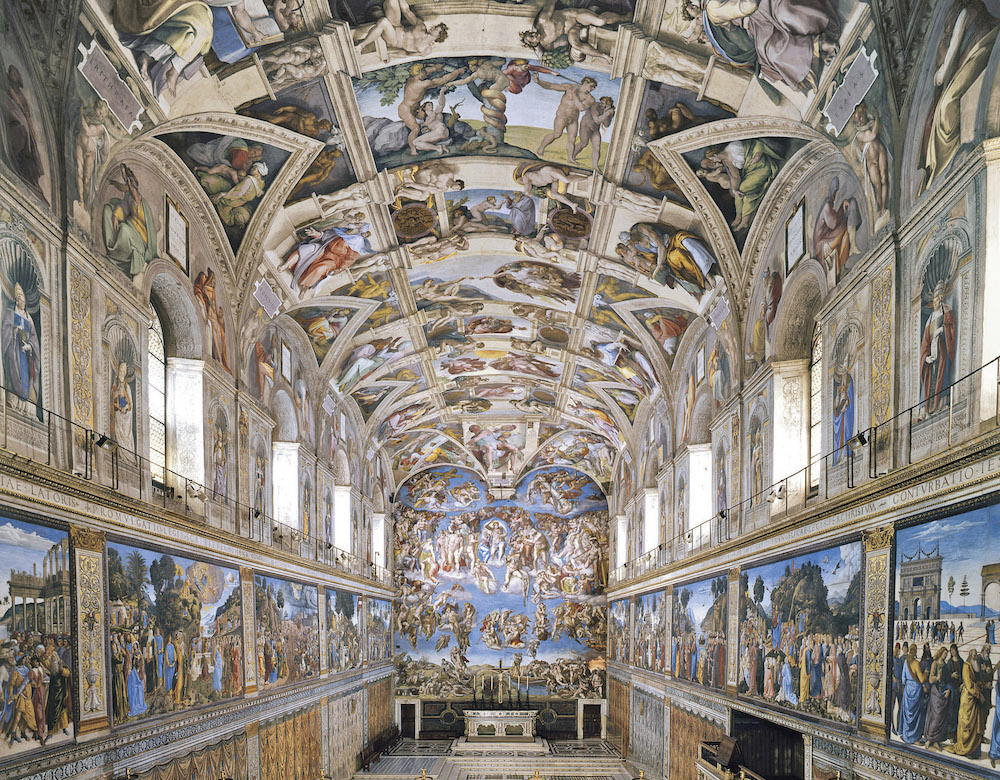In his 1999 letter to artists, Pope John Paul II explained that “the Church needs art. Art must make perceptible, and as far as possible attractive, the world of the spirit, of the invisible, of God. It must therefore translate into meaningful terms that which is in itself ineffable.” The Ecumenism of Beauty, a collection of essays edited by Timothy Verdon, a Catholic priest in Florence who directs the Mount Tabor Ecumenical Center for Art and Spirituality, demonstrates how visual and visceral art can attempt to translate the ineffable
Verdon, a Yale-educated art historian, follows Paul VI’s perspective that art “might become an instrument of communion among separated Christians.” He looks to the publication of Martin Luther’s theses as the historical and aesthetic origin of this separation. In the hundred years that followed, there was a “polarization of the aesthetics of collected prayer in Europe, as Catholics enriched their temples with even grander altarpieces and statuary groups, while Protestants stripped away virtually all decoration.”
The difference was not merely one of ornamentation. In Catholic spaces such as the painting of the Antwerp Cathedral by Pieter Neefs the Elder, “scattered believers are shown moving freely amid paintings of Christ, Mary, and various saints placed above altars.” In contrast, Dutch Protestant painter Pieter Jansz Saenredam’s vision of Saint Odulphus, Assendelft is of bare walls. All eyes face the “preacher speaking from the monumental pulpit.”
But Verdon is more interested in ecumenism than contrast. He turns to the Gospel for an ecumenical tradition of the visual: “anyone who sees me sees the Father” (John 14:9) and “He is the image of the unseen God” (Colossians 1:15). Here Verdon suggests that artists serve a particularly important, “quasi-sacramental function.” Hearkening back to the Lucan narrative of Jacob falling asleep, and dreaming that he “saw heaven and earth joined together,” Verdon writes that the “creative context is thus numinous: the appropriate spiritual state is a rapture that may be experienced as weariness, exhaustion . . . One must indeed be disoriented if one would create: must perceive oneself on new and marvelous terrain that seems somehow ‘the house of God,’ ‘the gate of heaven.’”
Equally important is the role of the faithful as recipients of this spiritual art. Verdon directs us to Gregory the Great’s admonition that the faithful should move from visio, or simply observing a painting, to adoratio, a sense of “ardent compunction” before God. We are stirred and shaken by authentically spiritual art; in fact, we might often feel the pangs of discomfort. In that way, spiritual art can unite Christians across denominations in the visceral experience of the Gospels—think of the power of the Passion as read and viewed during Mass.
The essays in The Ecumenism of Beauty look across Christian denominations to demonstrate the ways in which artists have produced images, sculptures, and other visuals as affirmations of belief. Jérôme Cottin offers a correction to the assumption that Protestants are essentially disinterested in spiritual art by considering Jean Calvin. Cottin argues that Calvin denounced certain images of medieval devotion that were laced with superstition, but praised “the image as a locus of a contemplation that is aesthetic and indeed also spiritual.” He points out that three essential Western visual artists “were Calvinist Christians or influenced by Calvinist culture”: Rembrandt, Van Gogh, and Piet Mondrian. While acknowledging the paradoxes of Calvin’s positions about art and image, devotion and deviation, Cottin’s conclusion is useful: that contemporary artists might channel “Calvin’s reticence about expressing God using human forms of representation” and therefore “pass from artistic metaphors to biblical ones—from the contemplation of artworks to the meditation of biblical texts.”
An essay by William Dryness finds a metaphor in the tendency of Protestant churches to be “still mostly locked during the week,” whereas Catholic and Orthodox spaces are open to the faithful. Dryness suggests that this tradition of locked churches meant “a revolution of personal devotion was being signaled,” that the faithful “should pray at home with the family, in the blacksmith shop while working, or while traveling.” Luther and Calvin’s focus on “the spirituality of everyday life,” claims Dryness, need not result in the absence of “visual beauty” in spaces of worship. He hopes that Protestants might continue to consider the spirit of Vatican II and Pope John Paul II, and embrace “visual beauty as a sign of God’s presence.”
The Ecumenism of Beauty offers much for Catholics and Protestants to consider. The spirit of the book is best captured in a quote provided by artist Filippo Rossi, who shares the words of Pope Benedict XVI, spoken in 2009 at the Sistine Chapel: “Art, in all its expressions, whenever it faces the great questions of existence, with the fundamental themes from which the meaning of life derives, can assume religious meaning and transform itself in an itinerary of deep inner meditation and spirituality.”
Nick Ripatrazone has written for Rolling Stone, Esquire, The Atlantic, and is a Contributing Editor for The Millions. He is writing a book on Catholic culture and literature in America for Fortress Press.
Start your day with Always Forward, our award-winning e-newsletter. Get this smart, handpicked selection of the day’s top news, analysis and opinion, delivered to your inbox. Sign up absolutely free today!

